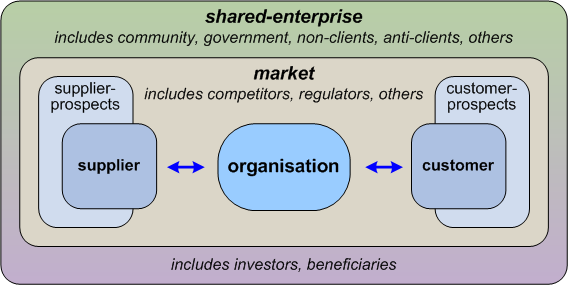On stakeholders
Who are our stakeholders? How do we identify our stakeholders?
This one came up from the back-and-forth during my ‘Backbone and edge‘ presentation at the IASA UK Summit in London last week. One of the sections in the presentation was about stakeholders and stakeholder-relations in enterprise-architecture and service-management, and I suggested that we could use this quick test to identify who a stakeholder for a service might be:
Definition of ‘stakeholder’: person who can wield sharp pointed stake in your direction…
It raised a fair amount of pained laughter, so I duly tweeted it later for more general amusement. Back came the following response from enterprise-architect Eric Stephens:
- EricStephens: or one that can say “no”
Very much true: the public-sector in particular seems riddled with business-stakeholders who can all say ‘No’ – often vociferously so – yet it often seems that no-one actually has the authority or the courage to say ‘Yes’…
IT-architect Richard Kernick added an important rider:
- thefullkernick: “Definition of ‘stakeholder’: person who can wield sharp pointed stake in yr direction… ” but not limited to those with power
Or, perhaps more importantly, not limited solely to those who think they ‘have the power’ – most typically the budget-holders, in a business context.
From my own perspective, in whole-scope enterprise-architecture, I’d say that by definition, everyone in the shared-enterprise is a stakeholder in anything that happens in that enterprise. Where many people working on change-projects would consider perhaps only a few specific executives or business decision-makers as ‘the stakeholders’, I’d suggest that the scope of stakeholders that we actually need to review should look something more like this:
In short, if they’re in the enterprise, they’re a stakeholder of the enterprise: simple as that.
What’s not simple – not at all simple – is identifying the various trade-offs and criticalities and priorities between all of those different stakeholders and their respective motivations and drivers. But at least once we stop pretending that only “those with power” are relevant, we can start to see what actually happens in an enterprise and the organisations that operate within that shared-enterprise.
The blunt fact we need to face is that that conventional concept of “those with power” is often very misleading, both about what ‘power’ actually is, and who it is that can wield those sharp-pointed stakes that can do us and our projects a lot of damage – seemingly without warning.
A typical example of the impact of ‘unexpected stakeholders’ is what’s known in executive-recruiting as the ‘trailing-spouse problem’. Let’s imagine you’ve been head-hunting for some while for a new CIO for your corporation’s New York headquarters, and you’ve at last found the perfect candidate, over in London. Everything checks out: availability, visa, everything. There’s only one catch: none of her family can move with her – her husband is a partner in a London law-firm, her teenage children are well settled in their school, and her diabetic elderly father needs scheduled medical care. And they’re all direct stakeholders in that potential role – despite the fact that none of them will ever be on the company’s payroll. Even if we do somehow convince our candidate to take the job anyway, the usual end-result of the ‘trailing-spouse problem’ is that – within two years or less, on average – there’ll be a divorce, either metaphorically between candidate and company, or literally between candidate and spouse. No-one wins… but especially so if people fail to understand just how real that ‘hidden-stakeholder’ risk truly is.
So yes, a possibly-useful summary here:
- ‘the stakeholders’ are not just the people who hold the budget
- it’s not just the people who can say ‘Yes’
- it’s not just the people who can say ‘No’
- it’s not just the people who think that they are ‘the ones with the power’
- it’s also not just the people for whom the service ostensibly is designed
Instead:
- stakeholders can be anyone in the same shared-enterprise
- every stakeholder is capable of wielding a sharp pointed stake in your direction
You Have Been Warned, perhaps? 🙂

Great post Tom; lot more than I was able to fit into my tweet but very much in line with my thinking. Just one correction: I’m not an IT architect. Nice to have met you at the iasauk.
Oops… my apologies, Richard. I kinda gleaned the title ‘IT architect’ from your Twitter-profile and tweets, but obviously I got it wrong: any suggestion for what I should put in its place? Or would you prefer no work-title at all?